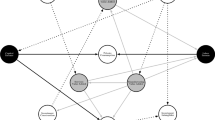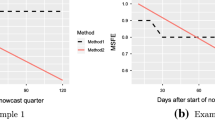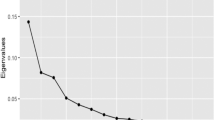Abstract
We compare the factor forecasting performance of nested specifications of the generalized factor model based on various configurations of a large macroeconomic data set. The forecast simulation design involves in-sample model selection, factor estimation, parameter estimation and, finally, generating factor forecasts and factor augmented autoregressive forecasts. To empirically determine the importance of the size and the structure of the data set, we run the forecast simulation design for different configurations of the data set. We compare the factor model diagnostics of each specification and data configuration with the corresponding forecast performance. The results favour the factor structure as the specification that imposes the factor structure to the least extent and, hence, is allowed most flexibility to adapt to the data, is significantly being outperformed. Moreover, the results show that size matters as though smaller macroeconomic data sets exhibit stronger coherence, the factors being well fit, however, generally do not show improved forecasting performance.
Similar content being viewed by others
References
Altissimo F, Cristadoro R, Forni M, Lippi M, Veronese G (2010) New Eurocoin: tracking economic growth in real time. Rev Econ Stat 92(4): 1024–1034
Bai J, Ng S (2002) Determining the number of factors in approximate factor models. Econometrica 70: 191–221
Bai J, Ng S (2008) Forecasting economic time series using targeted predictors. J Econom 146(2): 304–317
Bates J, Granger C (1969) The combination of forecasts. Oper Res Q 20: 451–468
Boivin J, Ng S (2005) Understanding and comparing factor-based forecasts. Int J Central Bank 1: 117–151
Boivin J, Ng S (2006) Are more data always better for factor analysis. J Econom 132: 169–194
Brillinger D (1981) Time series: data analysis and theory. Holdan-Day, San Francisco ISBN 0-89871-501-6
Caggiano G, Kapetanios G, Labhard V (2011) Are more data always better for factor analysis? Results for the Euro area, the six largest Euro area countries and the UK. J Forecast 30(8): 736–752
Clements M, Hendry D (1998) Forecasting economic time series. Cambridge University Press, Cambridge ISBN 0-19-828700-3
D’Agostino A, Giannone D (2012) Comparing alternative predictors based on large-panel dynamic factor models. Oxford Bull Econ Stat 74(2): 306–326
Efron B, Hastie T, Johnstone I, Tibshirani R (2004) Least angle regression. Ann Stat 32(2): 407–499
Eickmeier S, Ziegler C (2008) How successful are dynamic factor models at forecasting output and inflation? A meta-analytic approach. J Forecast 27(3): 237–265
Forni M, Lippi M (2001) The generalized dynamic factor model: representation theory. Econ Theory 17: 1113–1141
Forni M, Hallin M, Lippi M, Reichlin L (2000) The generalized factor model: identification and estimation. Rev Econ Stat 82(4): 540–554
Forni M, Highfield F, Palm F, Zellner A (2001) Coincident and leading indicators for the Euro area. Econ J 111: 62–85
Forni M, Hallin M, Lippi M, Reichlin L (2004) The generalized factor model: consistency and rates. J Econom 119(2): 231–255
Forni M, Hallin M, Lippi M, Reichlin L (2005) The generalized dynamic factor model: one-sided estimation and forecasting. J Am Stat Assoc 100(471): 830–840
Garcia-Ferrer A, Forni M, Hallin M, Lippi M, Reichlin L (1987) Macroeconomic forecasting using pooled international data. J Bus Econ Stat 5: 53–67
Giacomini R, White H (2006) Tests of conditional predictive ability. Econometrica 74(6): 1545–1578
Gómez V, Maravall A (1996) Programs tramo and seats, instructions for the user (beta version September 1996). Working Paper 9628, Bank of Spain
Hoogstrate A, Pfann G, Palm F (2000) Pooling in dynamic panel data models. J Bus Econ Stat 18: 274–283
Jacobs J, Otter P, den Reijer A (2012) Information, data dimension and factor structure. J Multivar Anal 106: 80–91
Palm F, Zellner A (1992) To combine or not to combine? Issues of combining forecasts. J Forecast 11: 687–701
Priestley M (1982) Spectral analysis and time series. ISBN 0-12-564922-3
Rünstler G, Benk S, Cristadoro R, Den Reijer A, Jakaitiene A, Jelonek P, Rua A, Ruth K, Van Nieuwenhuyze C (2009) Short-term forecasting of GDP using large scale monthly datasets: a pseudo real-time forecast evaluation exercise. J Forecast 28(7): 595–611
Schumacher C (2007) Forecasting German GDP using alternative factor models based on large datasets. J Forecast 26(4): 271–302
Schumacher C (2010) Factor forecasting using international targeted predictors: the case of German GDP. Econ Lett 107(2): 95–98
Stock J, Watson M (2002a) Forecasting using principal components from a large number of time predictors. J Am Stat Assoc 97: 1167–1179
Stock J, Watson M (2002b) Macroeconomic forecasting using diffusion indexes. J Bus Econ Stat 20: 147–162
Svensson L (2005) Monetary policy with judgment: forecast targeting. Int J Central Bank 1(1): 1–54
Van Els P, Vlaar P (1996) Morkmon iii, een geactualiseerde versie van het macro-economische beleidsmodel van de nederlandsche bank. Research Memorandum WO&E 471, De Nederlandsche Bank
Zou H, Hastie T (2005) Regularization and variable selection via the elastic net. J R Stat Soc B 67(2): 301–320
Author information
Authors and Affiliations
Corresponding author
Electronic Supplementary Material
The Below is the Electronic Supplementary Material.
Rights and permissions
About this article
Cite this article
den Reijer, A.H.J. Forecasting Dutch GDP and inflation using alternative factor model specifications based on large and small datasets. Empir Econ 44, 435–453 (2013). https://doi.org/10.1007/s00181-012-0560-x
Received:
Accepted:
Published:
Issue Date:
DOI: https://doi.org/10.1007/s00181-012-0560-x




